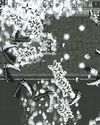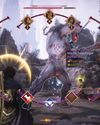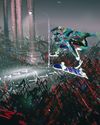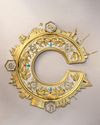The controls are exquisitely calibrated, giving you room to adjust your trajectory in mid-air.

Partway through Celeste, our mountaineer protagonist Madeline suffers a panic attack. Luckily, her occasional climbing companion, the affable Theo, has a surefire method to calm her down. Visualise a feather, he says, and breathe in and out rhythmically – imagining that each breath out is keeping it airborne. Sure enough, it rises and falls as we push a button, and before long Madeline has regained her composure. That this comes after one of the game’s most frustrating sequences doesn’t appear to be accidental. The technique, it seems, is as much for the player’s benefit as for its hero’s.
That’s because Celeste is one of those games: a pixelart platformer that constantly teeters on the edge of a precipice, the finest of margins separating compulsion and frustration. And, boy, does designer Matt Thorson know it. It’s obvious from the outset, when Madeline tells an old woman of her ambition to climb the titular peak, and the woman’s mocking laughter follows her into the next screen. It’s there, too, when Madeline smashes a mirror and a purple-haired doppelganger emerges – this is, essentially, her inner doubt, the part of her that suggests she should turn back. “Are you the weak part of me, or the lazy part?” Madeline grunts. “I’m the pragmatic part,” her grinning double replies.
Diese Geschichte stammt aus der March 2018-Ausgabe von Edge.
Starten Sie Ihre 7-tägige kostenlose Testversion von Magzter GOLD, um auf Tausende kuratierte Premium-Storys sowie über 8.000 Zeitschriften und Zeitungen zuzugreifen.
Bereits Abonnent ? Anmelden
Diese Geschichte stammt aus der March 2018-Ausgabe von Edge.
Starten Sie Ihre 7-tägige kostenlose Testversion von Magzter GOLD, um auf Tausende kuratierte Premium-Storys sowie über 8.000 Zeitschriften und Zeitungen zuzugreifen.
Bereits Abonnent? Anmelden

BONAPARTE: A MECHANIZED REVOLUTION
No sooner have we stepped into the boots of royal guard Bonaparte than we’re faced with a life-altering decision.

TOWERS OF AGHASBA
Watch Towers Of Aghasba in action and it feels vast. Given your activities range from deepwater dives to climbing up cliffs or lumbering beasts, and from nurturing plants or building settlements to pinging arrows at the undead, it’s hard to get a bead on the game’s limits.

THE STONE OF MADNESS
The makers of Blasphemous return to religion and insanity

Vampire Survivors
As Vampire Survivors expanded through early access and then its two first DLCs, it gained arenas, characters and weapons, but the formula remained unchanged.

Devil May Cry
The Resident Evil 4 that never was, and the Soulslike precursor we never saw coming

Dragon Age: The Veilguard
With Dragon Age: The Veilguard, BioWare has made a deeply self-conscious game, visibly inspired by some of the best-loved ideas from Dragon Age and Mass Effect.

SKATE STORY
Hades is a halfpipe

SID MEIER'S CIVILIZATION VII
Firaxis rethinks who makes history, and how it unfolds

FINAL FANTASY VII: REBIRTH
Remaking an iconic game was daunting enough then the developers faced the difficult second entry

THUNDER LOTUS
How Spirit farer's developer tripled in size without tearing itself apart